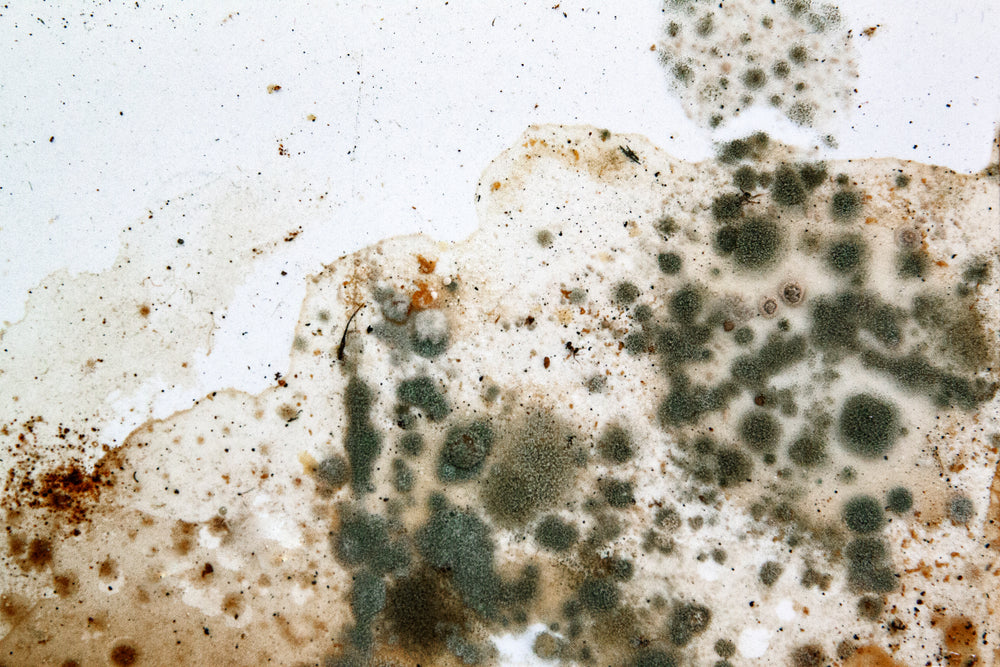Understanding Chaetomium Mold: Symptoms, Health Risks and Safe Levels

Share
Mold can be a persistent and troublesome issue in homes and buildings, affecting indoor air quality and potentially causing health problems. Chaetomium is one type of mold that is often found in water-damaged buildings. In this article, we will explore Chaetomium, its symptoms, safe levels, and its potential health effects.
What is Chaetomium?

Chaetomium is a genus of mold commonly found in soil, decaying plant material, and water-damaged building materials. It belongs to the Ascomycota phylum and can produce both sexual and asexual spores. Chaetomium is characterized by its dark-colored, woolly-textured appearance, making it easily distinguishable from other types of mold. (1)
The Chaetomium genus comprises various species, each with its unique characteristics. Some common Chaetomium species include Chaetomium globosum, Chaetomium murorum, Chaetomium bostrychodes, and Chaetomium atrobrunneum. The specific species of Chaetomium can influence its appearance, growth habits, and potential health effects.
Chaetomium Mold Growth
Chaetomium mold thrives in areas with high moisture content. When buildings experience water damage, such as flooding or leaks, it creates the ideal conditions for Chaetomium to grow. It can develop on a variety of surfaces, including drywall, wood, paper, and fabrics, making it a common issue in homes and commercial buildings.
Chaetomium Symptoms
Identifying a Chaetomium mold infestation can be challenging since it shares some similarities with other types of mold. Common symptoms associated with Chaetomium mold exposure may include:
- Musty Odor: Chaetomium emits a distinct, musty odor that can be an early indicator of its presence. This odor is often described as earthy or mildew-like.
- Visible Growth: The mold typically appears white at first but gradually changes to gray, brown, or black as it matures. It has a cotton-like texture.
- Water Damage: Chaetomium is commonly found in areas with a history of water damage. Inspect areas with leaks, floods, or persistent dampness.
- Health Effects: Exposure to Chaetomium mold can lead to various health symptoms, including allergies, respiratory issues, and skin irritation. (2)
Chaetomium Safe Levels
Determining safe levels of Chaetomium mold can be challenging, as mold tolerance varies from person to person. However, it's generally agreed upon that any visible mold growth in indoor environments is undesirable and should be remediated. The presence of Chaetomium mold suggests an underlying moisture problem that needs to be addressed.
To assess the extent of mold contamination, professionals often conduct indoor air quality tests and surface sampling. The results are compared to established mold guidelines and regulations. Acceptable levels of Chaetomium and other molds may vary depending on local regulations and guidelines, so it's essential to consult with local health authorities or mold experts for specific recommendations.
Chaetomium Health Effects

Exposure to Chaetomium mold can have various health effects, particularly in individuals who are sensitive or allergic to mold. (3) These effects may include:
- Respiratory Issues: Chaetomium spores can be inhaled, leading to respiratory symptoms such as coughing, wheezing, and nasal congestion.
- Allergies: Mold allergies can manifest as sneezing, runny or itchy nose, itchy or watery eyes, and skin rashes.
- Skin Irritation: Direct contact with Chaetomium mold or its mycotoxins can cause skin irritation and rashes.
- Headaches and Fatigue: Prolonged exposure to mold can result in persistent headaches and fatigue.
- Exacerbation of Existing Conditions: Individuals with asthma, allergies, or other respiratory conditions may experience worsened symptoms when exposed to Chaetomium mold.
It's important to note that the severity of these health effects can vary widely among individuals. Some people may be more sensitive to mold than others, and preexisting health conditions can influence the response to mold exposure.
Chaetomium Treatment

If you suspect that you or someone you know has been exposed to Chaetomium mold and is experiencing health effects, it is essential to take appropriate steps for treatment. Here's what you need to know about addressing health issues related to Chaetomium exposure:
- Seek Medical Attention: If you experience symptoms associated with Chaetomium mold exposure, such as respiratory issues, allergies, skin irritation, headaches, or fatigue, it's crucial to consult a healthcare professional. Provide your healthcare provider with a detailed history of potential mold exposure and the specific symptoms you are facing.
- Medical Evaluation: Your healthcare provider will conduct a thorough evaluation to determine the cause of your symptoms. This may include a physical examination, review of your medical history, and potentially allergy testing.
- Symptom Management: Depending on the severity of your symptoms, your healthcare provider may recommend treatments to alleviate discomfort. These treatments may include antihistamines for allergies, bronchodilators for respiratory issues, or topical creams for skin irritation.
- Eliminate Mold: Depending on the severity of your symptoms, your doctor may prescribe medications to eliminate any mold buildup in the body. It may also be beneficial to supplement with a mold cleanse tonic to support the elimination of mold and mycotoxins and to support immune health.
- Environmental Intervention: Confirming that Chaetomium exposure is the cause of your health issues, it is important to address the source of mold contamination in your living or working environment. Consult with professionals experienced in mold remediation to identify and remove the mold source. This process may include fixing leaks, enhancing ventilation, and replacing contaminated materials.
- Preventive Measures: After addressing immediate health concerns, take steps to prevent future mold exposure. This includes maintaining proper ventilation, controlling humidity levels, and promptly addressing water damage or leaks.
- Consulting Specialists: In severe cases of mold-related health issues, it may be necessary to consult specialists such as allergists or pulmonologists for a comprehensive evaluation and ongoing care.
Individual responses to mold exposure can vary significantly, and treatment approaches should be tailored to specific symptoms and circumstances. If you suspect Chaetomium mold exposure and experience persistent or severe health issues, do not hesitate to seek medical advice and professional assistance for mold remediation. Prevention and early intervention are key to mitigating health risks associated with Chaetomium mold exposure.
References
1 https://www.ncbi.nlm.nih.gov/pmc/articles/PMC8466430/